THE REALITY OF VIRTUALNESS
Exploring the Transformative Power of Virtual Reality: Meaning, Invention, Types, Uses, Impacts, and Contributions
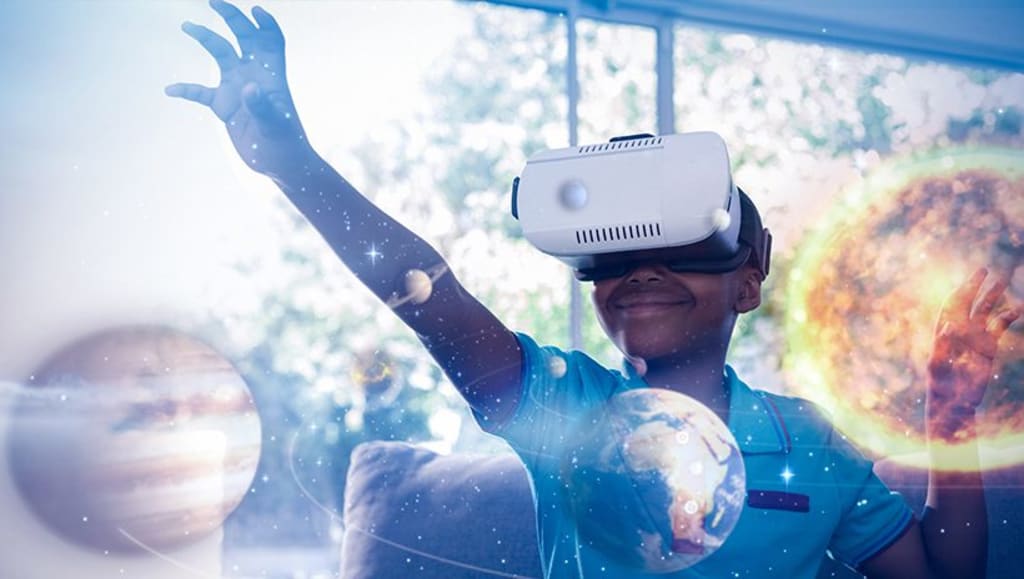
》ABSTRACT《
Virtual Reality (VR) has emerged as a groundbreaking technology that offers immersive and interactive experiences in a simulated environment. This comprehensive essay delves into the meaning and invention of VR, highlighting its inventors, their goals, and the evolution of VR technology. It examines the various types and forms of VR and explores its extensive range of applications across different domains. The essay further explores the contributions of VR to the world, discussing its impacts on individuals and society. Specifically, it investigates the role of VR in gaming and other life activities and how it enhances human proficiency and facilitates a more convenient lifestyle. Through this in-depth analysis, we aim to shed light on the immense potential of VR as a transformative technology.
● Introduction
•1 Definition of Virtual Reality:
Virtual Reality (VR) refers to a computer-generated, interactive, and immersive simulation of a three-dimensional environment that can be explored and experienced by an individual using specialized electronic devices, such as headsets or goggles. In virtual reality, users are transported to a digitally created world that can mimic real-world settings or be entirely fictional. The goal of VR is to provide users with a sense of presence, allowing them to perceive and interact with the virtual environment as if it were real.

●Invention of Virtual Reality●
The invention of virtual reality (VR) involved a series of pioneering efforts by visionary individuals who contributed to the development and advancement of this transformative technology. While the concept of VR can be traced back to early immersive experiences, the invention of modern VR as we know it today can be attributed to several key milestones and inventors.

•3 Overview of key inventors:
Several key inventors have played pivotal roles in the development and advancement of virtual reality (VR) technology. Their visionary ideas, inventions, and contributions have laid the foundation for the immersive and interactive experiences that VR offers today. Here is an overview of some of the key inventors of VR:
■ Morton Heilig: Morton Heilig, often considered the "Father of Virtual Reality," was a filmmaker and inventor who created the Sensorama in the 1950s. The Sensorama was a mechanical device that provided a multi-sensory experience, including stereoscopic 3D visuals, stereo sound, vibrations, and even scents. Heilig's work laid the groundwork for immersive experiences that later shaped the development of VR.
■ Ivan Sutherland: Ivan Sutherland is a pioneering computer scientist and one of the early visionaries in VR. In the 1960s, he developed the first virtual reality head-mounted display (HMD) called the "Sword of Damocles." The HMD was a bulky apparatus suspended from the ceiling that used a tracking system to provide users with a wireframe virtual environment. Sutherland's work on "The Ultimate Display" concept influenced subsequent generations of VR technology.
■ Jaron Lanier: Jaron Lanier is a computer scientist, philosopher, and musician who coined the term "Virtual Reality." In the 1980s, he founded VPL Research, where he and his team developed various VR devices and technologies, including the DataGlove and the EyePhone HMD. Lanier's contributions to VR helped popularize the field and contributed to its early advancements.
■ Thomas Furness: Thomas Furness, often referred to as the "Grandfather of Virtual Reality," is an American inventor, engineer, and researcher. He founded the Human Interface Technology Lab (HITLab) at the University of Washington, where he pioneered virtual and augmented reality technologies. Furness's work focused on developing VR systems for military training and flight simulation, contributing significantly to the advancement of VR applications.
■ Palmer Luckey: Palmer Luckey is the founder of Oculus VR, a company known for its groundbreaking VR headset, the Oculus Rift. Luckey's invention revolutionized the consumer VR market by introducing high-quality, immersive experiences accessible to a broader audience. Oculus Rift, along with its subsequent iterations and advancements, played a crucial role in the resurgence of VR technology.
■ Mark Bolas: Mark Bolas is a renowned virtual reality researcher and inventor who has made significant contributions to the field. He has worked on various VR projects, including the development of the Virtual Environment Display System (VEDS), a VR system that combined HMDs with tracking technologies. Bolas's research and inventions have contributed to advancements in VR technology and its applications.
These inventors, among many others, have shaped the evolution of virtual reality through their innovative ideas, research, and inventions. Their contributions have paved the way for the immersive, interactive, and transformative experiences that VR offers today.
● Goals of Virtual Reality Inventors:
The inventors of virtual reality (VR) technology shared common goals that drove their research, inventions, and advancements in the field. These goals were focused on creating immersive and interactive experiences, expanding human perception and understanding, and enhancing communication and collaboration. Here are the key goals of VR inventors:
■ Immersive Experiences:VR inventors aimed to create immersive experiences that transport users into virtual worlds, enabling them to feel a sense of presence and engagement. By designing realistic and interactive virtual environments, inventors sought to create experiences that would suspend disbelief and allow users to perceive the virtual world as if it were real. This goal involved developing technologies that could replicate sensory inputs, such as visuals, audio, and haptic feedback, to enhance the feeling of immersion.
■ Expanded Human Perception and Understanding: Another important goal of VR inventors was to expand human perception and understanding of the world around them. By simulating different environments, scenarios, and perspectives, VR technology offered the potential to explore new realms, experience historical events, or gain insights into abstract concepts. Inventors sought to provide users with a means to perceive and interact with data, information, and simulations in a more intuitive and immersive manner, thereby enhancing learning, exploration, and creativity.
■ Enhanced Communication and Collaboration: VR inventors recognized the potential of the technology to revolutionize communication and collaboration. They aimed to develop VR systems that would enable people to interact with each other and shared virtual spaces, regardless of physical distance. By creating immersive environments for remote collaboration, inventors sought to enhance teamwork, enable virtual meetings, and foster a sense of presence and connectedness among users. This goal involved developing technologies for avatar representation, real-time communication, and shared virtual workspaces.
■ Human-Machine Interaction: VR inventors also focused on improving human-machine interaction. They aimed to create interfaces and interaction techniques that were more natural and intuitive, enabling users to manipulate virtual objects and navigate virtual environments with ease. By developing technologies such as hand controllers, gesture recognition, eye tracking, and haptic feedback devices, inventors sought to bridge the gap between the physical and virtual worlds, allowing users to interact with digital content in a more embodied and intuitive manner.
■ Empowering Education, Training, and Simulations: VR inventors recognized the potential of VR for education, training, and simulations. They aimed to develop immersive and realistic training environments that would enable users to practice skills, learn new concepts, and simulate complex scenarios in a safe and controlled manner. By leveraging the interactive and immersive nature of VR, inventors sought to enhance learning outcomes, improve training effectiveness, and reduce risks associated with real-world simulations.
Overall, the goals of VR inventors revolved around creating immersive experiences, expanding human perception, improving communication and collaboration, enhancing human-machine interaction, and empowering education and training. Their visionary ideas and efforts have led to the development of a transformative technology that continues to shape various industries and domains.
》 TYPES AND FORMS OF VIRTUAL REALITY《
Virtual reality (VR) technology comes in various types and forms, each offering unique features, levels of immersion, and use cases. Here are the main types and forms of virtual reality:
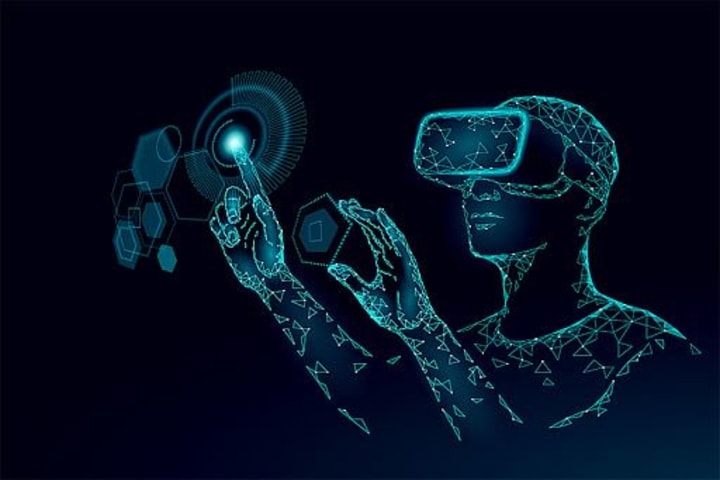
■ Non-Immersive VR: Non-immersive VR, also known as desktop or screen-based VR, involves experiencing virtual reality through a traditional computer screen without wearing a head-mounted display (HMD). Users interact with the virtual environment using input devices such as a keyboard, mouse, or gamepad. This type of VR provides a limited sense of immersion and is commonly used for simulations, training, and visualization applications.
■ Semi-Immersive VR: Semi-immersive VR incorporates a larger display or projection system to provide a more immersive experience than non-immersive VR. It often includes surround screens or projection walls that surround the user, creating a wider field of view. Users may use special input devices such as data gloves or motion-tracking controllers to interact with the virtual environment. Semi-immersive VR is commonly utilized in training, research, and entertainment applications.
■ Fully Immersive VR: Fully immersive VR offers the highest level of immersion by completely surrounding the user with virtual stimuli. It typically involves wearing a head-mounted display (HMD) that covers the user's eyes and ears, blocking out the physical world. These HMDs provide stereoscopic visuals and often include built-in headphones for spatial audio. Fully immersive VR may also incorporate additional sensory feedback through haptic suits or devices that provide tactile sensations. This type of VR is commonly used in gaming, simulations, and virtual experiences.
■ Augmented Reality (AR): Augmented reality combines virtual elements with the real world, overlaying computer-generated graphics or information onto the user's view of the physical environment. AR is experienced through devices such as smartphones, tablets, smart glasses, or headsets that allow users to see both the real world and virtual elements simultaneously. AR is utilized in various applications, including gaming, education, navigation, and industrial applications.
■ Mixed Reality (MR): Mixed reality is a blend of virtual reality and augmented reality, allowing virtual objects to interact with the real world. MR devices, such as the Microsoft HoloLens, enable users to see and interact with virtual content while maintaining awareness of their physical surroundings. This technology is commonly used in industrial design, architecture, and training applications.
■ 360-Degree VR: 360-degree VR involves capturing or rendering a complete spherical view of a real or virtual environment. Users can experience these immersive environments using HMDs or by simply moving their perspective within a browser or mobile application. 360-degree VR is widely used for virtual tours, video experiences, and live events.
■ Web-Based VR: Web-based VR refers to virtual reality experiences that can be accessed directly through web browsers without the need for specialized applications or downloads. These experiences are often created using web technologies such as WebGL and WebVR/WebXR, allowing users to access VR content easily through their devices.
These various types and forms of virtual reality cater to different levels of immersion, interaction, and application requirements. Each type offers unique possibilities and opportunities for entertainment, education, training, visualization, and other fields. The choice of VR type depends on the intended use and the level of immersion and interactivity desired for a particular application.
● Uses of Virtual Reality
Virtual reality (VR) has found applications in a wide range of industries and fields, revolutionizing the way we interact, learn, and experience various scenarios. Here are some of the key uses of virtual reality:

■ Gaming and Entertainment:
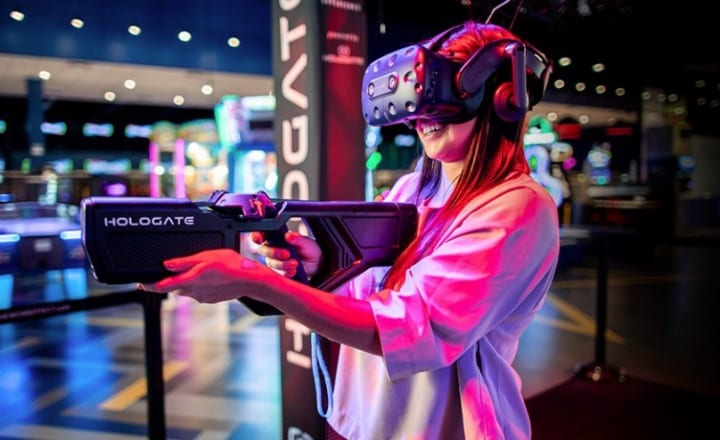
VR has had a significant impact on the gaming industry, providing immersive and interactive experiences for gamers. It allows players to step into virtual worlds, interact with objects and characters, and experience gameplay from a first-person perspective. VR gaming offers a heightened sense of presence and engagement, creating a more immersive and realistic gaming experience.
■ Training and Simulation:

VR is extensively used for training and simulation purposes in industries such as aviation, military, healthcare, and manufacturing. It provides a safe and controlled environment for trainees to practice skills, perform complex procedures, and experience realistic scenarios without real-world risks. VR-based training enhances learning outcomes, improves retention, and allows for repetitive practice.
■ Education and Learning:

VR has the potential to transform education by offering immersive and interactive learning experiences. It enables students to explore historical events, visit virtual museums, travel to distant places, and interact with 3D models and simulations. VR-based learning enhances student engagement, facilitates experiential learning, and makes complex concepts more accessible and understandable.
■ Architecture and Design:

VR is used in architecture and design industries for creating virtual walkthroughs and visualizations of buildings, interiors, and urban environments. It allows architects, designers, and clients to experience and evaluate designs before construction, making it easier to identify potential issues and make informed decisions. VR-based design reviews provide a realistic and immersive perspective, enhancing the design process.
■ Healthcare and Therapy:
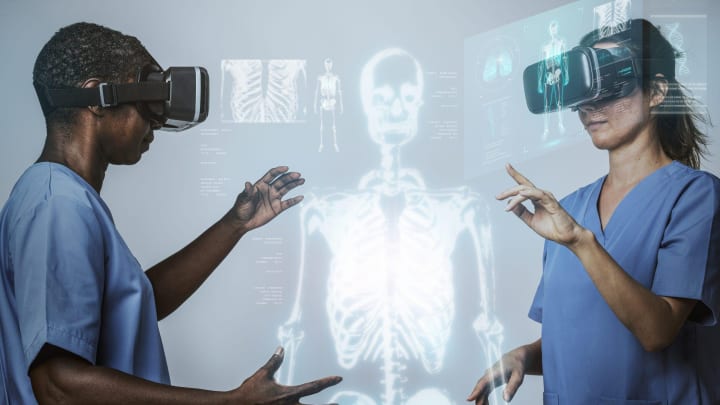
VR finds applications in healthcare for medical training, pain management, and therapy. Medical students can practice surgical procedures and interact with virtual patients. VR is also used for pain distraction during medical procedures, phobia treatment, and rehabilitation therapies. It provides a controlled and immersive environment for therapeutic interventions.
■ Virtual Tourism and Exploration:

VR enables virtual tourism, allowing users to experience and explore destinations and landmarks from the comfort of their homes. It offers immersive virtual tours of famous sites, natural wonders, and cultural heritage sites. VR-based exploration provides a new way to experience and appreciate the world, making travel accessible to a broader audience.
These are just a few examples of the diverse uses of virtual reality. As the technology continues to evolve, new applications and possibilities are emerging in areas such as marketing, sports training, social experiences, mental health, and more. VR has the potential to reshape industries, transform experiences, and create new avenues for innovation.
● Contributions of Virtual Reality to the World
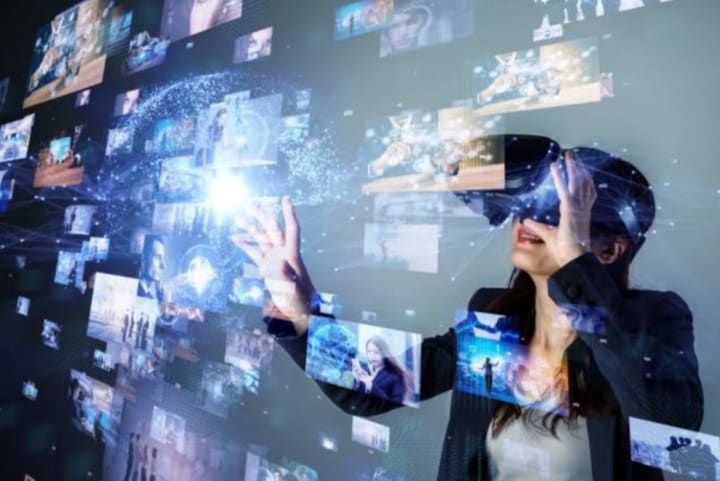
Virtual reality (VR) technology has made significant contributions to various aspects of our world, bringing about transformative changes and advancements. Here are some key contributions of virtual reality:
■ Enhanced Experiences and Immersion: VR has revolutionized the way we experience and interact with digital content. It provides a high level of immersion, allowing users to feel present and engaged in virtual environments. VR enhances experiences in gaming, entertainment, education, training, and simulations by creating realistic and interactive environments that go beyond traditional media formats.
■ Improved Training and Education: VR has had a profound impact on training and education. It offers immersive and interactive simulations for various industries, including healthcare, aviation, military, and manufacturing. VR-based training allows learners to practice skills in a safe and controlled environment, leading to improved learning outcomes, better retention, and reduced costs associated with real-world training.
■ Advancements in Healthcare: Virtual reality has brought significant advancements to the healthcare industry. It is used for medical training, surgical simulations, and patient education. VR-based therapy is employed in pain management, phobia treatment, and rehabilitation. Additionally, VR has facilitated telemedicine, enabling remote consultations and virtual examinations, particularly useful in providing healthcare access to remote areas.
■ Architectural Visualization and Design: VR has transformed the architectural and design industries by enabling immersive visualizations and walkthroughs. Architects and designers can create virtual representations of buildings and spaces, allowing clients to experience designs before construction. This contributes to better decision-making, improved collaboration, and enhanced communication among stakeholders.
■ Cultural Preservation and Virtual Tourism: VR has contributed to the preservation and exploration of cultural heritage sites. It enables virtual tours of historical landmarks, museums, and archaeological sites, providing access to inaccessible or endangered locations. VR-based virtual tourism allows people to experience destinations and cultures remotely, fostering cultural appreciation and expanding travel opportunities.
■ Technological Advancements and Innovation: The development of VR technology has led to advancements in various related fields. It has spurred innovation in display technology, tracking systems, haptic feedback, and user interfaces. VR has also driven progress in areas such as computer graphics, computer vision, and human-computer interaction, contributing to the overall advancement of technology.
■ Collaboration and Communication: VR has transformed remote collaboration and communication. It enables users from different locations to meet in virtual environments, interact with shared content, and collaborate on projects in real-time. VR-based communication fosters a sense of presence and connection, reducing geographical barriers and enhancing teamwork and creativity.
These contributions demonstrate the transformative potential of virtual reality across multiple domains. As VR continues to evolve and become more accessible, it is expected to have an even more significant impact on industries, education, healthcare, and our daily lives.
● Impacts of Virtual Reality on Individuals and Society
■ Psychological and emotional effects
■ Ethical considerations and concerns
■ Social implications and changes in behavior
■ Impact on communication and relationships
■ It has opened up new avenues for innovation and revenue generation.
These impacts illustrate the transformative influence of virtual reality on individuals and society. As VR technology continues to advance and become more accessible, its effects will continue to shape various aspects of our lives and drive further innovation.
● Improving Human Proficiency and Facilitating Life
■ Virtual reality for skill development and training
■ Enhancing productivity and efficiency in various industries
■ Virtual reality for remote work and collaboration
■ Virtual reality as a tool for relaxation and stress reduction
》Conclusion《
Virtual reality (VR) holds tremendous transformative potential across multiple domains. It has the ability to revolutionize industries, enhance experiences, and reshape the way we interact with digital content. In summary, VR has the potential to transform industries, enhance learning and training, improve healthcare, enable virtual social interactions, preserve cultural heritage, drive innovation, and empower individuals. As the technology continues to evolve and become more accessible, its transformative potential will continue to shape our lives and drive new possibilities in various fields.
This essay provides an extensive exploration of virtual reality, from its inception to its various applications and impacts. By examining the goals of its inventors, the essay highlights the significant contributions of VR to different domains, such as entertainment, education, healthcare, and more. Moreover, it evaluates the effects of VR on individuals and society, focusing on the role of VR in gaming and other life activities. Finally, the essay discusses how VR improves human proficiency and enhances daily life by increasing productivity and convenience.
About the Creator
Enjoyed the story? Support the Creator.
Subscribe for free to receive all their stories in your feed. You could also pledge your support or give them a one-off tip, letting them know you appreciate their work.
Reader insights
Outstanding
Excellent work. Looking forward to reading more!
Top insights
Excellent storytelling
Original narrative & well developed characters
Expert insights and opinions
Arguments were carefully researched and presented
Eye opening
Niche topic & fresh perspectives
On-point and relevant
Writing reflected the title & theme

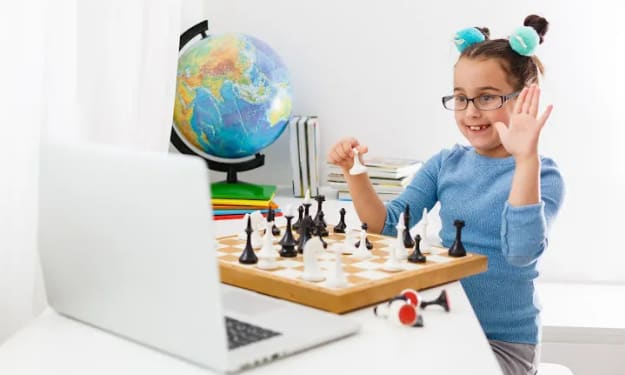



Comments (1)
Thanks for the time you took to prepare this